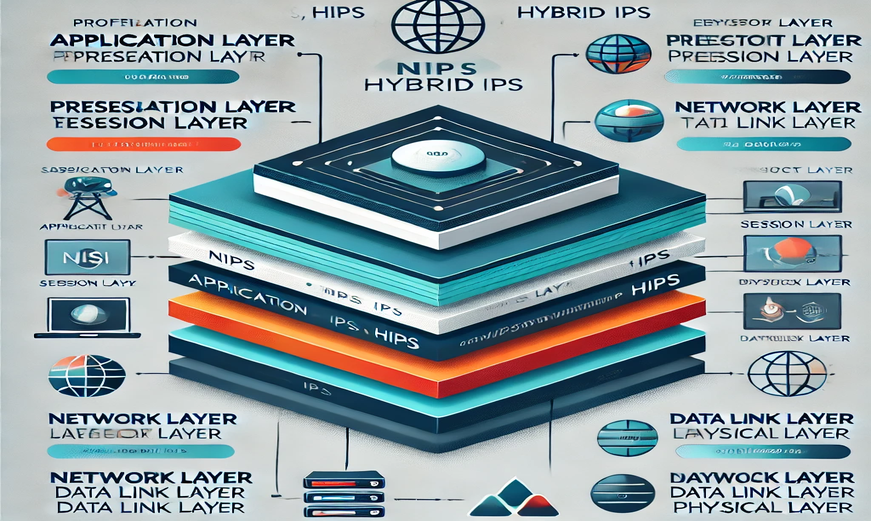Understanding Intrusion Prevention Systems (IPS)
🛡️An Intrusion Prevention System (IPS) is a critical technology for proactively detecting and blocking security threats at both the network and host levels. However, in today’s environment—where threats are diverse and increasingly sophisticated—it is limiting to view IPS purely as a single-point solution. Implementing multiple security tools in a so-called multi-layered defense model can lead to compatibility issues, alert fatigue from redundant notifications, and fragmented budgets and personnel.
Therefore, even if you consider every layer of the OSI model, it is far more efficient and effective to adopt a unified security platform that protects both the network and hosts in an integrated manner, rather than mindlessly adding separate security devices.

1. IPS and OSI Model-Based Security
Network communications are often evaluated through the 7-layer OSI model. IPS addresses these layers differently, requiring distinct defensive strategies at each level.
Layer 3: Network Layer
- IP Address-Based Filtering Identifies and blocks malicious actions such as IP spoofing or abnormal routing attempts.
- Routing Rules Restricts unnecessary inter-network traffic, reducing the overall attack surface by limiting access to internal resources.
Layer 4: Transport Layer
- Port Number Filtering Mitigates DoS attacks like port scans (searching for open ports) or SYN floods (repeatedly targeting a specific port).
- Session Management Tracks TCP/UDP connection states, detecting abnormal patterns or excessive simultaneous connections for quick containment.
Layer 7: Application Layer
- HTTP Traffic Analysis Inspects SQL injection, XSS, or web shell uploads hidden in web requests, blocking malicious payloads before they reach the server.
- Encrypted Traffic With HTTPS or TLS, it’s difficult to thoroughly inspect packets at the network layer. Hence, host-based security (e.g., HIPS) plays a critical role in monitoring behaviors after decryption.
2. Network-Based Security Solutions: Firewalls and WAF
At the network layer, two essential security components are the classic firewall and the Web Application Firewall (WAF).
Network & Transport Layers: Firewall
-
IP and Port Filtering Preemptively blocks unwanted traffic, preventing unauthorized access to critical servers or internal assets. This serves as the most fundamental line of defense.
-
Stateful Inspection Unlike stateless filtering, which examines packets in isolation, stateful inspection tracks the entire connection (session). For example, it checks whether TCP’s 3-way handshake completes normally and identifies abnormal connection attempts. While it cannot inspect encrypted packet contents, it can still detect suspicious traffic based on session data and statistical metrics (e.g., number of connections, session duration).
Application Layer: Web Application Firewall (WAF)
- Web Request Inspection A security solution specialized for web applications, the WAF inspects malicious patterns (e.g., SQL injection code) hidden in HTTP(S) requests.
- Customized Policies Because the WAF’s rules can be finely tuned to each application, it excels at application-layer security more so than a traditional firewall. However, analyzing encrypted traffic requires SSL decryption and additional configuration.
3. The Importance of Host-Based Security Solutions
Relying solely on network-layer solutions has a major drawback: it’s difficult to fully inspect encrypted traffic. To address this, host-based security solutions (e.g., HIPS) operating directly within each server or PC are indispensable.
Encrypted Traffic and the Host Layer
- Decryption Point TLS/HTTPS data eventually gets decrypted within the host (server) itself. This is where host-based solutions can closely monitor actual application processes.
- Real-Time Behavioral Analysis They can block malicious actions by evaluating filesystem activity, memory modifications, and inter-process communications from a holistic perspective.
Examples of Host-Based Solutions
- Antivirus/Anti-Malware Identifies and removes viruses or ransomware hidden in files, preventing system compromise.
- Endpoint Detection & Response (EDR) More advanced solutions that continuously track anomalous behavior at the host level and automatically respond to detected threats or alert administrators.
- Data Loss Prevention (DLP) Monitors for attempts to exfiltrate encrypted sensitive data or personal information and blocks unauthorized transfers.
- Application Whitelisting Restricts software execution to approved programs, reducing the security risks posed by unverified applications.
- Security Information and Event Management (SIEM) Collects logs from both hosts and network devices, enabling comprehensive threat detection and incident response across the entire organization.
4. A Comprehensive Definition of IPS
As the above illustrates, IPS is not just “a single device or program preventing network intrusions.” Rather, it’s a cooperative effort—
- Network Level: Firewalls, WAFs, routing policies, etc.
- Host Level: HIPS, EDR, DLP, SIEM, etc.
All of these work in unison to prevent intrusions across multiple layers. In modern environments where encryption is widespread and cloud adoption is growing, host-based security is increasingly critical.
✍️ In other words, an Intrusion Prevention System (IPS) is not merely a standalone product, but a holistic security framework spanning both network and host defenses.
Additional Considerations and Warnings
-
Encrypted Traffic Challenges Firewalls or WAFs can use SSL inspection proxies to process encrypted packets, but this may introduce extra resource usage and privacy concerns. This highlights the growing importance of HIPS, EDR, and other host-level solutions.
-
Environment-Specific Requirements Every organization’s environment is unique in terms of traffic patterns, network architecture, and data criticality, requiring a tailored IPS design and deployment.
-
Continuous Updates and Monitoring Since attack techniques evolve rapidly, ongoing security patches and policy updates are crucial for both network and host-based tools.
💡 Bottom Line: A robust IPS strategy in modern environments means covering all layers of the OSI model, pairing network-based solutions with host-based defenses. Even as encryption technology evolves, stateful inspection, behavioral analysis, and centralized log management remain key to identifying and blocking threats from multiple angles.